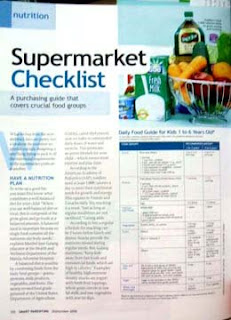
Date: September 2006
Publication: Smart Parenting
Section and Page: Nutrition, p.102
Publisher: Summit Media
Supermarket Checklist
A purchasing guide that covers crucial food groups
What we buy from the store and stack in our pantry says a lot about the nutrition we provide our kids. Budgeting is one thing, trying to pack in all the nutritional requirements in the supermarket pushcart is another.
Have a Nutrition Plan
To write up a good list, you must first know what constitutes a well-balanced diet for your child. “When you say well-balanced diet or meal, this is composed of the grow, glow, and go foods at a balanced amount. A balanced meal is important because no single food contains all the nutrients our body needs,” explains Maribel Jane Galang, educator at the Health and Wellness Department of the Manila Adventist Hospital.
A balanced diet is possible by combining foods from the basic food groups—grains, proteins, milk products, vegetables, and fruits. The newly revised food guide pyramid of the United States Department of Agriculture (USDA), called MyPyramid, now includes recommended daily doses of water and exercise. This promotes and active lifestyle for your child—whish means more exercise and play time.
According to the American Academy of Pediatrics (AAP), toddlers need at least 1,000 calories a day to meet their nutritional needs for growth and energy. This equates to 3 meals and 2 snacks daily. Yes, snacking is a must. “Just as long as regular mealtimes are not sacrificed,” Galang adds.
According to her, a regular schedule for snacking can be 2 hours before lunch and dinner. Snacks provide the nutrients missed during regular meals. But, Galang maintains, “Keep kids away from fast foods and commercial foods, which are high in calories.” Examples of healthy, high-nutrient-density snacks are yogurt with fresh fruit toppings, whole grain cereals in low fat milk, and raw vegetables with low-fat dips.
A purchasing guide that covers crucial food groups
What we buy from the store and stack in our pantry says a lot about the nutrition we provide our kids. Budgeting is one thing, trying to pack in all the nutritional requirements in the supermarket pushcart is another.

Have a Nutrition Plan
To write up a good list, you must first know what constitutes a well-balanced diet for your child. “When you say well-balanced diet or meal, this is composed of the grow, glow, and go foods at a balanced amount. A balanced meal is important because no single food contains all the nutrients our body needs,” explains Maribel Jane Galang, educator at the Health and Wellness Department of the Manila Adventist Hospital.
A balanced diet is possible by combining foods from the basic food groups—grains, proteins, milk products, vegetables, and fruits. The newly revised food guide pyramid of the United States Department of Agriculture (USDA), called MyPyramid, now includes recommended daily doses of water and exercise. This promotes and active lifestyle for your child—whish means more exercise and play time.
According to the American Academy of Pediatrics (AAP), toddlers need at least 1,000 calories a day to meet their nutritional needs for growth and energy. This equates to 3 meals and 2 snacks daily. Yes, snacking is a must. “Just as long as regular mealtimes are not sacrificed,” Galang adds.
According to her, a regular schedule for snacking can be 2 hours before lunch and dinner. Snacks provide the nutrients missed during regular meals. But, Galang maintains, “Keep kids away from fast foods and commercial foods, which are high in calories.” Examples of healthy, high-nutrient-density snacks are yogurt with fresh fruit toppings, whole grain cereals in low fat milk, and raw vegetables with low-fat dips.

No comments:
Post a Comment